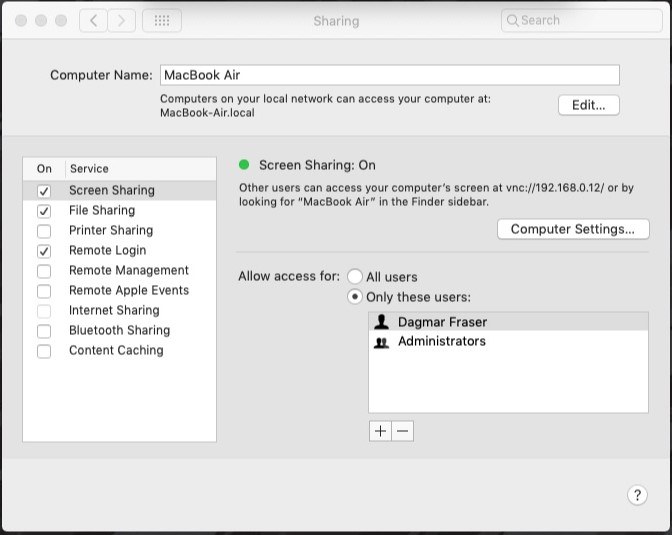REMOTE ACCESS TO PBIC FROM A MAC - OS: CATALINA
The pre-installed utilities Terminal and Screen Sharing will be used to set up and to display the remote PBIC session. You can find these using Spotlight on the Mac. Consider adding them to your launch bar.
Use Terminal to start a vncserver session
Enter the following at the command prompt in the terminal window, with username being your University ADF user name e.g. fraserds@pbic.bham.ac.uk
ssh username@pbic.bham.ac.uk
Enter your University ADF password when prompted.
Once successfully connected through ssh enter the following at the command prompt to start a VNC session:
vncserver
You may want to override the default desktop size (the default is 1024x768) to match your local desktop screen or laptop size. If, for example, you wanted a larger screen size of 1280x1024, amend the command as follows:
vncserver -geometry 1280x1024
You may want also want to override the default color depth (16 bits) to be 24 bit color:
vncserver -depth 24
Or you may want to do both at the same time:
vncserver -geometry 1280x1024 -depth 24
Note that you should only run the vncserver command once, the first time you connect to pbic.bham.ac.uk. Only if the vncserver session crashes or if the PBIC Cluster is rebooted should you run this command again. If you do already have a vncserver session running, do not try and run another server session. You should get a warning telling you that you already have a session running (and telling you which session number it is). If you do start multiple sessions, the later ones will be killed automatically.
If you have never run the vncserver before you will be prompted twice to set a password. To avoid later confusion it would be sensible to make this password the same as your regular University ADF login password.
When you run the vncserver command it will show the display name and number of the VNC session in the form:
|
pbic.bham.ac.uk:XX |
where XX is a one or two digit number. This is the display number of the virtual desktop.
Make a note of the XX number - it is your unique VNC session identifier.
You may now type "exit" to close this SSH session (or click "x" button on top right of window to close the Terminal window). The remote vncserver session you have started will stay running. So long as the remote computer pbic.bham.ac.uk is not rebooted, this virtual session will continue to run until you choose to kill it.
Connecting to your VNC session on PBIC
The following will need to be done each time you connect to pbic.bham.ac.uk
Open another Terminal window as you did earlier and enter the following at the command prompt, with username being your University ADF user name and XX your VNC server session number on PBIC:
ssh -L59XX:localhost:59XX username@pbic.bham.ac.uk
Enter your University ADF password when prompted, and you should see a Last Login.

Leave the above terminal running and open Screen Sharing, the following window will appear:

Enter the following for the entry Host:
localhost:59XX
Enter your VNC password and click on connect, you should now have an open VNC session on PBIC.
Troubleshooting
If this fails, you may need to alter some settings in the Sharing pane of Settings. Specifically, you will require Screen Sharing to be active. If you are already using another Remote Management client, you will not be able to tick Screen Sharing without first disabling Remote Management.

If this fails to remedy the situation it is possible you still have a previous SSH tunnel still open. Restarting your Mac will clear all active local sessions (but not kill the remote PBIC session!) and allow you to use Screen Sharing once more.
Finishing a VNC session - Shutting down the VNC server
Should you not need to keep the session alive then you should stop your vncserver to free up resources for other users. This can be done by using a Terminal window to connect to pbic.bham.ac.uk as above and then typing:
vncserver -kill :XX
where XX is your display number.
Useful VNC commands
|
vncserver -geometry 1280x1024 |
Start vncserver with specified display size |
|
vncserver -depth x24 |
Start vncserver with specified screen colour depth |
|
vncserver :xx |
Start specified vncserver session number |
|
vncserver -kill :xx |
End specified session number |
|
vncpasswd |
Change vncserver password |
|
vncwho |
|
